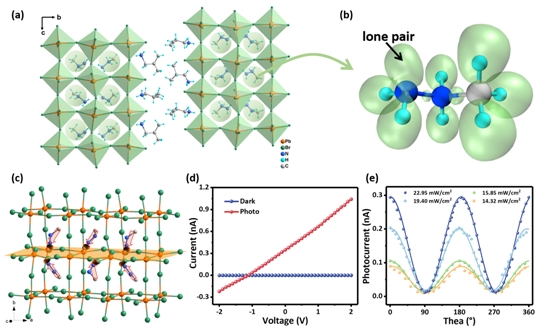The polarization ratio is thought to be an important index to evaluate the distinguishability in polarized photodetection devices because it is closely related to material semiconductor performance and structural anisotropy.
Owing to the directional arrangement of dipoles, the bulk photovoltaic effect (BPVE) can spatially promote carrier separation and transport, and generate steady-state current without external voltage, thereby greatly enhancing the polarization ratio. Despite great efforts have been made in chiral materials and ferroelectric materials, polar materials possessing remarkable semiconductor properties are extremely rare.
In a study published in Angew. Chem. Int. Ed., Prof. LUO Junhua and his colleagues from Fujian Institute of Research on the Structure of Matter of the Chinese Academy of Sciences reported a polar multilayer hybrid perovskite (IBA)2MHy2Pb3Br10 (IBA = iso-butylamine, MHy = methylhydrazine), which exhibits a large open-circuit voltage (Voc = 1.2 V) and outstanding polarization sensitivity (polarization ratio up to 24.6).
The researchers found that (IBA)2MHy2Pb3Br10 possesses a Ruddlesden–Popper (RP) type two-dimensional(2D) multilayered structure, which is composed of tri-layered [Pb3Br10]∞ inorganic sheets and IBA+ spacer.In detail, the organic and inorganic layers are alternate spatial arrangements, which not only improve the anisotropy of the structure but also effectively prevent carrier recombination and promote carrier transmission.
The electron localization function (ELF) calculations showed that the 2s2 lone pair electrons on the terminal N cations are almost of crescent shape, demonstrating the 2s2 are stereo-chemically active.
Besides, the researchers revealed that the lone-pair electrons in MHy+ cations result in the generation of dipole moments. The dipole moments aggregate to give polarization of (IBA)2MHy2Pb3Br10, which drives a steady open-circuit voltage. Polarized detectors using the single-crystal exhibit an ultrahigh polarization ratio of up to 24.6 in self-powered mode, and this ratio is a record for organic-inorganic hybrid perovskite single-crystals.
This study provides a new approach for the rational design of polar materials to realize high-performance polarization-sensitive photodetectors.

Illustration of the Research (Image by Prof. LUO’s group)
Contact:
Prof. LUO Junhua
Fujian Institute of Research on the Structure of Matter,
Chinese Academy of Sciences
E-mail: jhluo@fjirsm.ac.cn